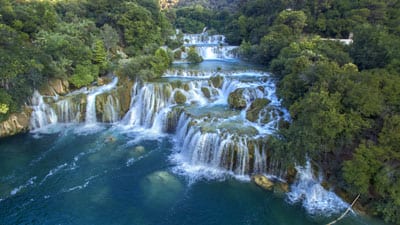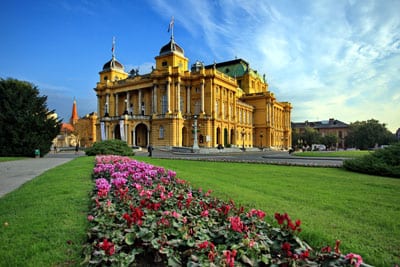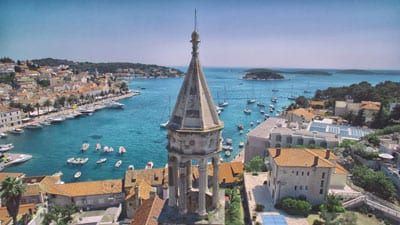Stretching along the Adriatic Sea, just a stone’s throw from Central Europe, Croatia is a country defined by a rich cultural legacy. Today, history perfectly combines with a youthful spirit and vibrant energy that prove irresistible to those seeking diversity. Breath-taking natural beauty, endless coastlines, diverse gastronomy, adventure, sports and wellness, can be enjoyed all year round.
Whether exploring the old city of Dubrovnik, a UNESCO World Heritage Site, island-hopping around the Split archipelago, truffle hunting in Istria, paragliding across the Plitvice Lakes, delving into Zagreb’s streets and hidden passages, birdwatching in Kopacki rit, partying the night away at Zrce beach in Novalja or taking time out with the family on Zlatni Rat beach, there truly is something for everyone in Croatia.
Whether your preference is hopping from one pristine island to the next along the Dalmatian Coast, dancing the night away in Hvar, exploring ancient sites and cultural heritage in Dubrovnik and Split, sampling the best local food and drink in Rovinj or enjoying a wide range of adventure sports in the Istria region – Croatia has plenty to offer for every taste and lifestyle
Breath-taking natural beauty, endless coastlines, diverse gastronomy, adventure, sports and wellness, can be enjoyed all year round
#1 DUBROVNIK is South Croatia’s most renowned hot spot and famous for its cultural heritage. Take a walk in its breath-taking, pedestrian-only Old Town, a UNESCO world cultural heritage, and explore the network of picturesque small streets and squares. One of the world’s most awe-inspiring walled cities, Dubrovnik has gained even more international fame since it doubles for the fictional ‘King’s Landing’ in HBO’s epic fantasy series Game of Thrones. Dubrovnik Summer Festival (10 July –25 August) is always a major draw and creates buzzing nightlife. For those preferring a calmer time, May/June and September/October are good months to visit the Dalmatian coastal town while December is a real insider tipp: Browse for unique presents at Dubrovnik’s Christmas Fair, enjoy culinary highlights in one of the city’s excellent restaurants and on New Year’s Eve, dance the night away with a cheerful crowd on main street.

#2 PLITVICE LAKES the country’s largest National Park, is situated in a mountainous karst area. A UNESCO World Heritage Site, the park is renowned for its 16 shimmering lakes, arranged in cascades and showcasing distinctive colours from azure to green, grey and blue. The colours change constantly depending on the number of minerals, organisms in the water, and the angle of sunlight. A unique way to view this incredible scenery is from a bird’s eye perspective, which you can do if you partake in hang-gliding or paragliding. The lakes are located in Lika region in the heart of Croatia, between the country’s continental and coastal parts. The region is a popular stopover for people travelling from Zagreb to the coast, but with its natural beauty, lush green landscapes, majestic mountains, sparkling clear springs and a high concentration of protected Nature Parks, it is worth exploring in its own right.

#3 SPLIT The story of Croatia’s second-largest city dates back 1700 years to Roman Emperor Diocletian who decided to build his Palace right on the peninsula where he wanted to spend the last years of his life. Since 1979, the entire historical core of Split, including Diocletian Palace, has been on the World Heritage UNESCO list and till today, all historical layers are alive and visible to visitors. But it is not only the city’s rich tradition and the beauty of its natural and cultural heritage that makes it irresistible. Local inhabitants sit in the same cafes and shop in the same stores as tourists, giving them the impression that, by arriving in Split, they become a part of the city and its rhythm.
#4 POREČ is a town of culture, tourism, sport and leisure, where the aromas and colours of past times form a mosaic of unforgettable experiences. Its history dates back to the time of the Roman Empire and can still be felt in the city centre, whose symmetrical geometric layout of streets has been preserved and captivates visitors with its picturesque location on a small peninsula submerged in the sea. Euphrasian Basilica from the 6th century is the most valuable cultural and historical monument in Istria and is on the UNESCO World Heritage List. As for the fun and nightlife: This summer, Poreč invites locals and visitors to its first Open Air Festival. From June 9th to September 10th the streets and squares of the historic city centre, as well as the enchanting Sveti Nikola Island, will come to life with more than a hundred cultural events and street performances. Every Friday, the sea before Poreč’s promenade will lend its surface for a spectacular laser show.
#5 ZADAR Awarded as “European Best Destination 2016”, the 3,000-year-old city of Zadar infuses historical heritage with breathtaking natural beauty to create a unique experience for visitors. Located in the northernmost part of Dalmatia, the coastal town is marked by its history and turned towards modernity. Take a stroll along the waterfront and listen to the “Sea Organ”, an experimental instrument which uses wind and waves to create music. Visit the largest Roman forum on the Croatian side of the Adriatic and the unforgettable Romanesque church of St. Donatus. A unique souvenir is Maraschino, a herbal fruit liqueur which was developed by pharmacists of Zadar’s Dominican monastery at the beginning of the 16th Century.
#6 ROVINJ is an old, picture-perfect town that stretches into the sea and is often referred to as the Med’s most romantic spot. Known for its diverse tourist offerings, it prides itself on having a newly designed, contemporary beach and promenade in Lone Bay, which runs 200 metres along the beach. Rovinj is located in the region of Istria, the Adriatic Sea’s largest peninsula, which is a world-renowned gourmet destination. Local specialities include black and white truffles which are among the most prized in the world, fresh seafood, wild asparagus, top-rated olive oils and award-winning wines. Boasting great natural beauty, Istria also offers a wide range of adventures in the great outdoors such as paragliding, free climbing, canyoning, exploration of caves, horseback riding, mountain running and biking – perfect for those seeking an active holiday.

#7 ZAGREB Croatia’s capital is a city of contrasts: Young and old at the same time, it is dedicated to business in the morning but relaxed and fun in the evening. In the past, it was often unfairly overlooked by visitors to Croatia, but now comes into its own thanks to rich urban offerings including culture, the arts, music, theatre, architecture and gastronomy. In 2016, Zagreb’s Maksimir park was awarded one of the most beautiful European parks by European Best Destinations. Founded back in 1794, it is home of a hundred-year-old oak forest and the City ZOO, making it a refreshing getaway from hot days. Zagreb is a year-round outdoor city: in spring and summer Jarun Lake is a popular sunbathing and sailing destination; autumn offers hikes in Samobor, and winter ski adventures can be found at nearby Mt Medvednica.

#8 HVAR island is the number-one holder of Croatia’s superlatives: most luxurious island, sunniest place in the country (2724 hours of sunshine each year) and, along with Dubrovnik, most popular tourist destination. The island’s capital is a must-visit destination for those seeking fun and nightclubbing and for those who love seeing and being seen. It is all about swanky hotels, elegant restaurants, posh yachts, trendy bars and clubs. The best way to explore Hvar and its neighbouring 79 islands and some 500 islets that run parallel to the Dalmatian coast is to charter a gulet and go island hopping.
#9 SLAVONIJA region in the East is Croatia’s best-kept secret. It is shaped by the force of the mighty Drava, Danube and Sava rivers and characterised by a distinctive, captivating rural landscape, featuring endless golden agricultural plains, hills peppered with excellent vineyards and one of Europe’s largest, most preserved wetlands, the Nature Park of Kopacki rit. The park covers an area of marsh and partly sunken forest, renowned for its abundant and rare fauna and flora, including almost 300 bird species. Slavonia’s history and ties to its neighbouring countries have created an intriguing cultural backdrop which is also reflected in its diverse regional cuisine: It is spicier than others in Croatia, using plenty of paprika and garlic as well as fresh fish from the rivers.
#10 OPATIJA was considered to be the summer destination du jour for the Viennese elite during the days of the Austro-Hungarian Empire, a legacy that is still evident in the many remaining belle époque villas. Its tourist tradition began in 1844, culminating in the opening of Hotel Kvarner in 1884 – the first on the Eastern coast of the Adriatic. Opatija spreads out along the coast between forested hills and the glistening Adriatic, with the town’s entire waterfront connected by a promenade. Located in the region of Kvarner and flanked by majestic mountains, it is a year-round destination offering an unparalleled combination of sea, islands and highlands. Don’t miss the region’s culinary speciality, Kvarner Scampi, which are considered to be the best in the world!
Source: HTZ